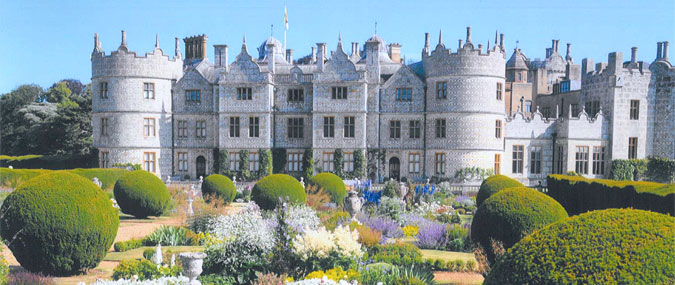 On 30 June, SocHistColl visited the unusual hexagonal country seat of Longford Castle, near Salisbury, for a private tour round the house, with time afterwards for a look round the splendid gardens, which looked particularly fine in their summer glory.
On 30 June, SocHistColl visited the unusual hexagonal country seat of Longford Castle, near Salisbury, for a private tour round the house, with time afterwards for a look round the splendid gardens, which looked particularly fine in their summer glory.
The visit was organised by Susanna Avery-Quash, who as Senior Research Curator (History of Collecting) at the National Gallery, is responsible for the public tours that the Gallery organises with Longford Castle. To start proceedings off, Susanna explained the long association that Longford has had with the National Gallery: some of the finest paintings now in the Gallery’s collection came from Longford, notably, Holbein’s Ambassadors and Poussin’s Adoration of the Golden Calf, while some other very great pictures from Longford are currently on loan at Trafalgar Square, including Holbein’s Erasmus. She explained how the partnership developed in a few years ago through a Collaborative Doctoral Award with Birkbeck University of London, through which research was undertaken into the collectors who built up the extraordinary art collections at Longford during the long eighteenth century. Dr Amelia Smith, the student who undertook the research, has subsequently published a book on the topic, which some members purchased at the end of their tour as a memento!
Longford’s chief guide, Alexandra Ormerod with one of the other two house guides, Paul Chapman, treated us to a really wonderful and eye-opening ‘double-act’ round the house, explaining how the collection had been formed by successive generations of the Des Bouverie family. The family were descended, they explained, from the Huguenot, Laurens Des Bouverie, who, having fled from religious persecution during the Reformation, settled in London and became a prosperous silk merchant, with his enterprising descendants becoming wealthy landowners in England. The family was ennobled in 1747 with Sir Jacob Des Bouverie becoming First Viscount Folkestone while his son, William, was created an Earl in 1765. Longford has continued to be home to the Earls of Radnor ever since and last year, 2017, they celebrated 300 years of residency at Longford.
As for the collections, Alexandra and Paul explained how the Radnor family had historically interested themselves in Italian and French art as well as art from the Low Countries, and how alongside purchasing paintings by the most esteemed masters of the day like Anthony van Dyck, Claude, Teniers and Hals, they had commissioned likenesses of family members from the most fashionable British portrait painters of the day like Hudson, Reynolds and Gainsborough. They also explained how paintings were just one of the type of objects purchased and how during the eighteenth century oriental porcelain, Brussels tapestries, and exceptional English and continental furniture had also been accumulated. The members enjoyed the chance to ask questions and share ideas and information with the guides and among themselves. Everyone went away having learnt a lot and having seen a cornucopia of beautiful works of art, with something for everyone’s tastes.
The trip was rounded off by a tasty Saturday lunch in the local pub where members could continue to relax with friend s and colleagues in a convivial atmosphere.
